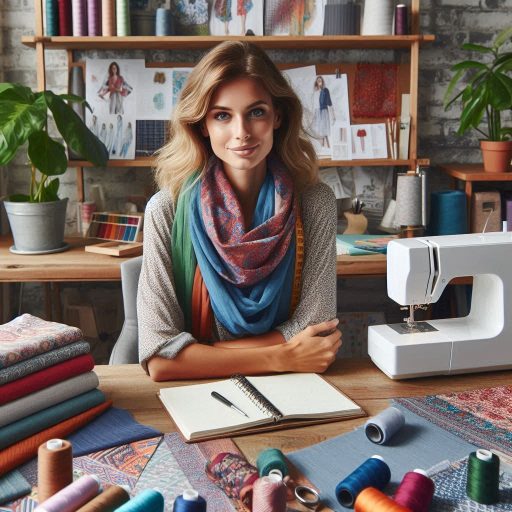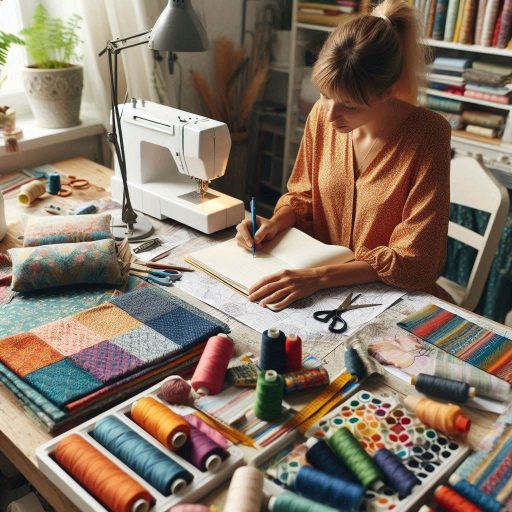Introduction
Attending textile design conferences is essential for industry professionals seeking to advance their careers.
These events create invaluable networking opportunities and insights into the latest trends shaping the textile landscape.
Designers, manufacturers, and suppliers gather to share knowledge and explore new ideas.
This collaborative environment allows attendees to connect with peers, potential clients, and industry leaders.
Conferences offer a unique chance to gain exposure to innovative ideas and emerging technologies.
Workshops and seminars led by experts enhance attendees’ skills and expand their knowledge base.
Participants can learn about new materials, sustainable practices, and cutting-edge design techniques.
Engaging in discussions with fellow attendees often sparks creativity and inspires future projects.
Moreover, conferences serve as a platform for personal and professional growth.
They allow attendees to stay updated on industry trends, which is crucial for maintaining relevance in a competitive field.
This blog post aims to provide practical tips for maximizing your experience at textile design conferences.
By following these suggestions, you can enhance your learning, seize networking opportunities, and forge meaningful connections within the textile industry.
Researching and Choosing the Right Conference
Attending textile design conferences can significantly enhance your knowledge and network.
To maximize your experience, follow these tips on researching and choosing the right conference.
How to conduct research on different textile design conferences
- Identify Key Events: Start by identifying key textile design conferences in your area or internationally.
Use online platforms like industry websites, social media, and forums. - Review Conference Websites: Visit each conference‘s official website.
Check details like dates, locations, speakers, and session topics. - Read Attendee Reviews: Look for reviews from past attendees.
Their experiences can provide valuable insights into the conference‘s value and organization. - Explore Social Media: Follow conferences on social media platforms.
Engaging with their posts can give you a sense of the conference’s community and culture. - Join Relevant Groups: Participate in textile design groups on platforms like LinkedIn or Facebook.
Networking with peers can lead to recommendations for valuable conferences.
Factors to consider when selecting a conference to attend
- Location: Consider the location of the conference.
Choose a venue that is accessible and convenient for you to attend. - Timing: Check the conference dates.
Ensure they align with your schedule and don‘t conflict with other commitments. - Themes and Topics: Review the conference themes and topics.
Ensure they cover areas of interest and relevance to your work. - Networking Opportunities: Look for conferences that provide networking events.
Meeting industry professionals can open doors for collaboration and mentorship. - Cost and Budget: Evaluate the cost of attending.
Include registration fees, travel expenses, and accommodation in your budget.
Importance of aligning conference themes with personal design interests and goals
- Identify Your Interests: Reflect on your personal design interests.
What specific areas of textile design excite you the most? - Set Professional Goals: Consider your professional goals.
Do you want to enhance specific skills, expand your network, or gain new knowledge? - Match Themes with Interests: Align the conference themes with your interests and goals.
Choose conferences that offer sessions and workshops relevant to your aspirations. - Prioritize Learning Outcomes: Focus on conferences that emphasize learning outcomes.
Ensure you can apply insights gained to your design practice. - Plan for Post-Conference Activities” Think about how you will implement what you learn.
Create a plan for applying insights and connections after the conference.
In summary, thorough research and thoughtful selection of conferences can enrich your textile design journey.
Focus on aligning the conference‘s offerings with your personal and professional objectives.
Read: Top Skills Needed for Art Educators and Instructors
Preparing and Planning Ahead
Attending a textile design conference can be a transformative experience.
To maximize your time, preparation is crucial.
Here are essential tips to help you plan effectively.
Tips for registering early to secure a spot at the conference
Secure your spot by registering as soon as possible.
Many conferences offer early bird discounts.
These savings can significantly reduce your costs.
Additionally, early registration ensures access to preferred workshops and sessions.
Popular events may fill up quickly, so don‘t wait.
You want to avoid missing out on valuable networking opportunities.
Creating a detailed itinerary and schedule for the conference
Crafting a detailed itinerary will keep you organized.
Start by reviewing the conference schedule.
Identify sessions that align with your interests and goals.
Mark keynotes, workshops, and panels that you want to attend.
Prioritize events based on their relevance to your work in textile design.
Make a daily schedule to manage your time effectively.
Include breaks and opportunities for networking.
This helps prevent burnout and allows you to recharge.
Consider setting reminders for important sessions.
This way, you won‘t miss any critical insights.
Packing essentials such as business cards, portfolio, notebook, and comfortable attire
Packing the right items is vital for a successful conference.
Start with business cards.
They serve as your introduction to potential collaborators and clients.
Ensure you have enough cards for networking events.
Include a portfolio showcasing your work.
This visual representation of your skills can impress new contacts.
Choose a compact, professional format for easy transport.
Don‘t forget to bring a notebook.
Use it to jot down ideas, insights, and contacts.
Writing things down helps reinforce what you learn.
A notebook also allows you to capture spontaneous thoughts during discussions.
Comfortable attire is essential for long days.
Choose clothing that is both professional and easy to move in.
Consider the conference venue‘s climate.
Layering can help you adapt to changing temperatures.
Bring a pair of comfortable shoes.
You may spend hours walking between sessions and networking.
Prioritize comfort to ensure you remain focused and engaged.
Plan for Networking
Networking is a crucial part of any conference.
Prepare an elevator pitch to introduce yourself quickly.
Highlight your skills and what you seek from the event.
Practice this pitch before the conference.
This will help you feel confident when meeting new people.
Utilize social media to connect with other attendees.
Join conference-related groups and discussions to build rapport before the event.
Engaging online can lead to fruitful conversations at the conference.
In general, preparing and planning ahead ensures a successful textile design conference experience.
Register early, create a detailed itinerary, and pack wisely.
This approach will help you maximize your time and opportunities.
Enjoy the event and make the most of your connections!
Read: Collaborating with Other Creative Roles
Networking Strategies
Attending textile design conferences offers valuable networking opportunities.
Connecting with fellow designers, industry professionals, and potential collaborators can enhance your career.
Building relationships at these events can lead to new projects, partnerships, and valuable insights.
Importance of networking with fellow designers, industry professionals, and potential collaborators
Networking is crucial in the textile design field.
It helps you exchange ideas and gain inspiration.
Meeting other professionals can provide new perspectives on your work.
Collaborating with others can open doors to innovative projects.
Establishing a strong network also increases your visibility in the industry.
People are more likely to remember you if you engage meaningfully.
How to approach people and initiate conversations at the conference
Initiating conversations at a conference can feel daunting.
Start by observing your surroundings.
Look for attendees who appear open to conversation.
Approach someone who shares a similar interest or background.
A friendly smile and eye contact can break the ice.
Begin with a simple introduction.
Share your name and a brief overview of your work.
Ask open-ended questions to encourage discussion.
For example, inquire about their favorite trends or projects.
Consider using conversation starters related to the conference.
Mention a keynote speaker or workshop you both attended.
This common ground can help you engage effectively.
Listen actively to their responses.
Show genuine interest in their experiences and opinions.
This creates a more meaningful interaction.
Tips for following up with contacts after the conference
After the conference, following up with your new contacts is vital.
Reach out within a week of the event.
A quick email or message can help you stay on their radar.
Remind them of your conversation to jog their memory.
Mention any specific details you discussed to personalize your message.
Express your appreciation for their insights or time.
If you exchanged business cards, reference that connection.
Invite them to connect on professional platforms like LinkedIn.
This fosters an ongoing relationship.
You can also share relevant articles or resources you discussed.
This demonstrates your commitment to maintaining the connection.
Consider scheduling a follow-up coffee or virtual meeting.
This allows for deeper conversations about potential collaborations.
It shows you value their expertise and insights.
Keeping the lines of communication open is essential.
Regular check-ins can strengthen your network over time.
Effective networking at textile design conferences can significantly impact your career.
Engage with fellow designers, approach people confidently, and follow up diligently.
By implementing these strategies, you can cultivate lasting relationships that benefit your professional journey.
Read: Breaking Down Iconic Movie Costumes

Attending Workshops and Seminars
Workshops and seminars are essential for textile design professionals.
They provide opportunities to expand skills and knowledge in a focused environment.
Here‘s how to make the most of these sessions.
Benefits of attending workshops and seminars to expand skills and knowledge
- Skill Enhancement: Workshops allow you to learn new techniques and methods directly from experts.
This hands-on experience is invaluable for developing your craft. - Networking Opportunities: These events gather like-minded individuals.
You can connect with peers, mentors, and industry leaders, fostering relationships that may benefit your career. - Knowledge Expansion: Seminars cover current trends and innovations in textile design.
Staying updated helps you remain competitive and informed in the industry. - Hands-On Experience: Many workshops include practical exercises.
Engaging in these activities solidifies your understanding and boosts your confidence.
Tips for choosing the most relevant and valuable sessions to attend
- Align with Your Goals: Identify your professional objectives before choosing sessions.
Focus on workshops that will help you meet those specific goals. - Research Presenters: Look for sessions led by industry leaders or recognized experts.
Their insights can provide you with cutting-edge knowledge and techniques. - Read Session Descriptions: Pay attention to what each session offers.
Select those that promise valuable takeaways aligned with your interests. - Seek Recommendations: Ask colleagues or mentors about their favorite sessions.
Their experiences can guide you in making informed choices.
How to actively participate in sessions and engage with the presenters
- Prepare Questions: Before attending, think about what you want to learn.
Prepare thoughtful questions to ask presenters during the sessions. - Engage with Presenters: Don’t hesitate to interact with speakers.
Share your insights or experiences related to the topic, creating a dialogue that enhances learning. - Take Notes: Keep detailed notes during sessions.
Jot down key points, ideas, and resources for future reference. - Network During Breaks: Use breaks to connect with fellow attendees.
Exchange contact information to build your professional network. - Follow Up: After the conference, reach out to presenters and fellow attendees.
Thank them for their insights and discuss any shared interests.
Attending workshops and seminars is vital for your growth in textile design.
By choosing the right sessions and actively participating, you can maximize your learning experience.
Embrace these opportunities to enhance your skills, expand your knowledge, and build valuable connections in the industry.
Read: Famous Costume Designers in Hollywood
Showcasing Your Work
Attending textile design conferences is an excellent opportunity to showcase your work.
Effectively presenting your portfolio and designs can make a lasting impression.
Here are key strategies to help you shine.
Strategies for presenting your portfolio or designs at the conference
- Curate Your Best Work: Select your strongest pieces that reflect your unique style.
Aim for quality over quantity. - Organize Your Portfolio: Arrange your work in a logical flow.
Consider grouping designs by theme or technique. - Use Digital Tools: Incorporate tablets or laptops for easy access.
Digital presentations allow for quick adjustments and a modern feel. - Include Physical Samples: Bring a few physical samples of your textiles.
Tangible pieces allow attendees to feel and appreciate your work. - Prepare Supporting Materials: Create handouts with your contact information and a brief description of each piece.
This helps attendees remember you after the conference.
Tips for setting up a visually appealing display to attract attention
- Choose a Clean Background: Use neutral colors that won‘t distract from your designs.
A simple backdrop highlights your work. - Utilize Good Lighting: Ensure your display is well-lit.
Good lighting enhances colors and textures in your textiles. - Create an Inviting Layout: Arrange your portfolio and samples in an eye-catching manner.
Use varying heights to draw attention. - Incorporate Visual Elements: Add props or decorations that align with your aesthetic.
This creates a cohesive and appealing display. - Be Approachable: Stand near your display and engage with attendees.
A welcoming demeanor encourages conversations about your work.
Importance of practicing your elevator pitch and being prepared to discuss your work
- Craft a Concise Message: Develop a short, engaging summary of your work.
Keep it under 30 seconds for maximum impact. - Highlight Key Features: Focus on what makes your designs unique.
Mention techniques, materials, or inspiration that set you apart. - Practice Makes Perfect: Rehearse your pitch multiple times before the conference.
Familiarity will boost your confidence when presenting. - Prepare for Questions: Anticipate questions about your work.
Think of insightful responses to showcase your expertise. - Be Authentic: Let your passion for textile design shine through.
Authenticity resonates with others and creates a lasting connection.
Showcasing your work at textile design conferences is crucial for networking and recognition.
Use these strategies to present your portfolio effectively, create an inviting display, and deliver a compelling elevator pitch.
Your hard work will pay off when you attract attention and make meaningful connections.
Transform Your Career Today
Unlock a personalized career strategy that drives real results. Get tailored advice and a roadmap designed just for you.
Start NowTaking Advantage of Vendor Exhibits
Attending textile design conferences offers a unique opportunity to explore vendor exhibits.
These exhibits showcase the latest materials, tools, and resources in the industry.
Here are some tips to make the most of your experience.
How to navigate vendor exhibits and explore new materials and resources
- Plan Your Route: Before the conference, review the exhibit map.
Identify vendors you want to visit. - Prioritize Your Interests: Focus on materials and resources relevant to your current projects.
- Allocate Time: Set aside specific times to explore exhibits.
This ensures you have ample time for each vendor.
Explore New Materials
- Touch and Feel: Engage with materials physically.
Experience textures and weight firsthand to understand their potential in your designs. - Take Samples: Request samples of materials that interest you.
This allows you to experiment later in your studio. - Ask for Demonstrations: Many vendors offer live demonstrations.
Attend these to learn about new technologies and applications.
Tips for networking with potential suppliers and partners at the exhibits
- Introduce Yourself: Start conversations with vendors.
A simple introduction can lead to valuable connections. - Exchange Contact Information: Bring business cards to share.
This helps you stay connected after the conference. - Engage in Discussions: Share your design challenges.
Vendors appreciate hearing about real-world applications for their products.
Importance of asking questions and seeking advice from vendors
- Be Curious: Don‘t hesitate to ask questions.
Inquire about product specifications, pricing, and customization options. - Request Expert Insights: Vendors often have vast industry knowledge.
Ask for advice on materials or techniques. - Discuss Trends: Talk about current industry trends with vendors.
This can lead to insights that may inspire your future designs.
Follow Up After the Conference
- Connect on Social Media: After the event, follow vendors on platforms like LinkedIn or Instagram.
This helps you stay updated on their latest offerings. - Send Thank-You Notes: Reach out to vendors you engaged with.
A thank-you note can reinforce connections and keep the dialogue open. - Share Your Projects: Update vendors on how you used their materials in your work.
This fosters a stronger relationship and shows your appreciation.
Vendor exhibits at textile design conferences present invaluable opportunities.
By navigating them strategically, exploring new materials, and networking effectively, you can enhance your design practice.
Remember, asking questions and seeking advice can lead to lasting partnerships.
Make the most of every interaction to ensure a successful conference experience.
Engaging with Keynote Speakers and Panelists
How to prepare questions and topics for discussion with keynote speakers and panelists
Before the conference, research the keynote speakers and panelists.
Understand their backgrounds, expertise, and recent work.
This knowledge helps you formulate relevant questions.
Aim for open-ended questions that encourage detailed responses.
For example, ask about current trends in textile innovation or sustainability practices.
Write down a list of questions ahead of time.
Prioritize them based on importance.
This preparation shows your genuine interest and can spark engaging discussions.
Tips for actively listening and participating in keynote presentations and panel discussions
During keynote presentations, focus on the speaker‘s message.
Avoid distractions, such as checking your phone or talking to others.
Active listening involves paying attention to both verbal and non-verbal cues.
Observe the speaker‘s body language and tone to grasp their passion and emphasis.
Take notes while listening.
Jot down key points, ideas, and any questions that arise.
This habit helps you remember important details and prepares you for later discussions.
Participating in Panel Discussions
Panel discussions often involve multiple speakers sharing diverse perspectives.
Engage actively by raising your hand to ask questions.
When your turn comes, ask your prepared questions or seek clarification on specific points.
This participation fosters a dynamic exchange of ideas.
If you have insights or experiences related to the topic, share them briefly.
Relating your background to the discussion can enrich the conversation.
Importance of taking notes and reflecting on key takeaways from the speakers
Taking notes during presentations is crucial for retaining information.
Capture essential concepts, statistics, and quotes.
Reflect on how these insights apply to your own work in textile design.
After each session, review your notes.
Highlight key takeaways and any ideas you wish to explore further.
This reflection solidifies your understanding and can inspire future projects.
Following Up After the Conference
After the conference, reach out to speakers and panelists.
Send them a brief email expressing gratitude for their insights.
If you asked a question, mention it and share your thoughts on their response.
This follow-up establishes a connection and shows your commitment to the field.
Consider connecting on professional networks like LinkedIn.
Engaging with speakers and panelists beyond the event can lead to valuable opportunities and collaborations.
Engaging with keynote speakers and panelists enriches your conference experience.
Prepare thoughtful questions, listen actively, and take notes to maximize learning.
Reflect on key takeaways and follow up after the event to foster lasting connections.
Your proactive approach can open doors in the textile design industry.
Delve into the Subject: Furniture Design Competitions to Enter in 2024
Conclusion
Attending textile design conferences can greatly enhance your career and creative journey.
Remember the key tips: plan ahead, engage with others, and showcase your work effectively.
Networking is invaluable; it connects you with industry leaders and fellow designers.
Each interaction can lead to new opportunities, collaborations, and friendships.
Learning from workshops and presentations will deepen your knowledge and skills.
Take notes during sessions, and don‘t hesitate to ask questions.
This will help you gain valuable insights that you can apply to your own projects.
Don‘t underestimate the importance of sharing your work; it builds your visibility in the industry.
Set up a portfolio or a display to attract attention and feedback.
Actively seek out critiques and suggestions from experienced professionals.
Apply these tips to maximize your conference experience.
Step out of your comfort zone and initiate conversations with attendees and speakers.
Take advantage of the resources and insights available at these events.
Embrace the chance to grow both personally and professionally.
Your active participation will yield lasting benefits.
Make every moment count, and enjoy the vibrant atmosphere of the textile design community.
Each conference is a unique opportunity to inspire and be inspired, so dive in and make the most of it!




